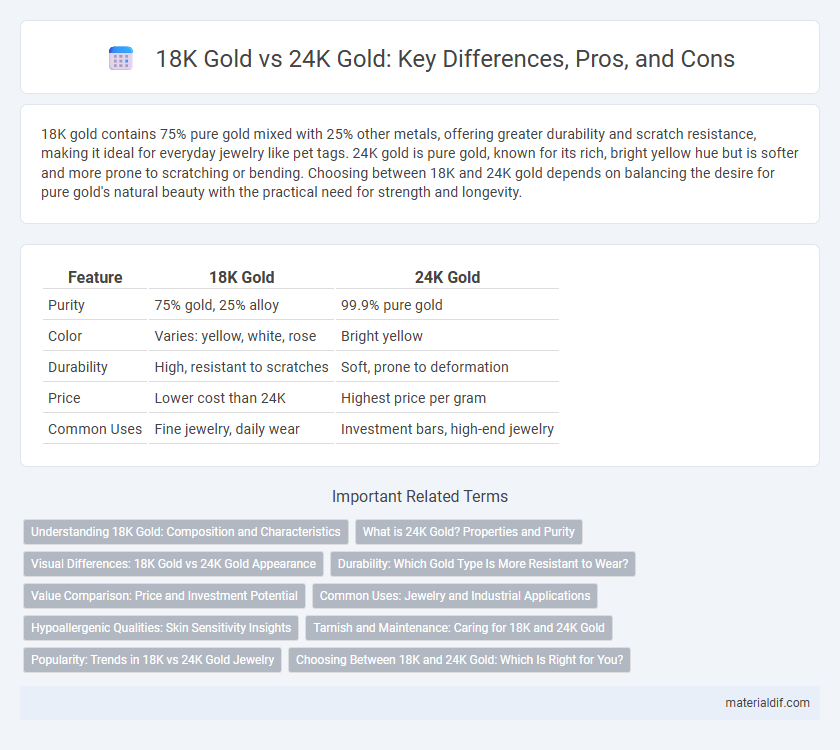18K gold contains 75% pure gold mixed with 25% other metals, offering greater durability and scratch resistance, making it ideal for everyday jewelry like pet tags. 24K gold is pure gold, known for its rich, bright yellow hue but is softer and more prone to scratching or bending. Choosing between 18K and 24K gold depends on balancing the desire for pure gold's natural beauty with the practical need for strength and longevity.
Table of Comparison
| Feature | 18K Gold | 24K Gold |
|---|---|---|
| Purity | 75% gold, 25% alloy | 99.9% pure gold |
| Color | Varies: yellow, white, rose | Bright yellow |
| Durability | High, resistant to scratches | Soft, prone to deformation |
| Price | Lower cost than 24K | Highest price per gram |
| Common Uses | Fine jewelry, daily wear | Investment bars, high-end jewelry |
Understanding 18K Gold: Composition and Characteristics
18K gold consists of 75% pure gold alloyed with 25% other metals such as copper, silver, or palladium, which enhances its durability compared to 24K gold. It features a rich, warm hue and is commonly used in fine jewelry due to its balanced combination of purity and strength. The alloying elements also influence the color variations of 18K gold, ranging from yellow to rose or white gold.
What is 24K Gold? Properties and Purity
24K gold is pure gold with a fineness of 99.9%, meaning it contains no other metals or alloys. It has a rich yellow color, is highly malleable, and is softer compared to 18K gold, making it less suitable for everyday jewelry wear. Due to its exceptional purity, 24K gold is often used in investment-grade bullion bars and coins.
Visual Differences: 18K Gold vs 24K Gold Appearance
18K gold has a richer variety of hues ranging from yellow to rose due to its alloy composition, which makes it more durable but less intensely yellow than 24K gold. 24K gold displays a pure, bright yellow color with a softer texture, often appearing more vibrant and reflective because it contains nearly 100% gold. The visual difference lies in 18K's slightly muted tone and increased hardness, compared to 24K's warm, luminous glow and softness.
Durability: Which Gold Type Is More Resistant to Wear?
18K gold, composed of 75% pure gold alloyed with stronger metals like copper and silver, offers superior durability and resistance to wear compared to 24K gold, which is nearly 100% pure and significantly softer. The increased hardness of 18K gold makes it ideal for everyday jewelry such as rings and bracelets that endure frequent contact and potential scratches. In contrast, 24K gold's softness leads to easier deformation and surface damage, reducing its long-term wear resistance.
Value Comparison: Price and Investment Potential
18K gold contains 75% pure gold and is alloyed with other metals, offering increased durability and a lower price point compared to 24K gold, which is 99.9% pure and commands a premium price due to its purity. Investment potential favors 24K gold for long-term value retention and market liquidity, while 18K gold suits everyday wear and affordability with moderate appreciation. Price per gram for 24K gold consistently exceeds 18K, reflecting its higher gold content and intrinsic value in bullion and jewelry markets.
Common Uses: Jewelry and Industrial Applications
18K gold, composed of 75% pure gold mixed with alloys, is favored in jewelry for its durability and rich color, making it ideal for rings, bracelets, and watches. In contrast, 24K gold, being nearly 100% pure, is softer and primarily used in high-end jewelry and specialized industrial applications like electronics and medical devices where corrosion resistance and conductivity are critical. The balance between purity and hardness defines 18K gold's widespread use in wearable items, while 24K gold's superior purity suits precision components and investment-grade items.
Hypoallergenic Qualities: Skin Sensitivity Insights
18K gold, composed of 75% pure gold and 25% alloy metals, offers improved durability but may cause allergic reactions due to mixed metals like nickel or copper. In contrast, 24K gold is nearly 100% pure, significantly reducing the risk of skin irritation or allergic responses, making it more suitable for sensitive skin. Choosing 24K gold minimizes exposure to potential allergens, enhancing hypoallergenic qualities favored by individuals with skin sensitivities.
Tarnish and Maintenance: Caring for 18K and 24K Gold
18K gold, composed of 75% pure gold alloyed with other metals, is more durable and resistant to tarnish compared to 24K gold, which is 99.9% pure and more prone to scratching and tarnishing due to its softness. Maintaining 18K gold typically requires less frequent cleaning and polishing, while 24K gold needs gentle care, avoiding harsh chemicals and abrasive materials to preserve its luster. Regular wiping with a soft cloth and proper storage in a dry, airtight environment can extend the lifespan and appearance of both 18K and 24K gold jewelry.
Popularity: Trends in 18K vs 24K Gold Jewelry
18K gold jewelry has gained widespread popularity due to its balanced combination of durability and rich color, making it a preferred choice for everyday wear and fashion-forward designs. In contrast, 24K gold, prized for its pure, intense yellow hue, remains favored primarily in investment and traditional ceremonial pieces, especially in Asian and Middle Eastern markets. Rising trends in 18K gold reflect consumer demand for versatile, high-quality jewelry that combines beauty with practicality.
Choosing Between 18K and 24K Gold: Which Is Right for You?
18K gold contains 75% pure gold mixed with alloys, offering increased durability and a variety of colors, making it ideal for everyday jewelry. 24K gold is 99.9% pure, prized for its rich, vibrant yellow hue but softer and more prone to scratches, better suited for investment or special occasion pieces. Choosing between 18K and 24K gold depends on your priorities for durability, appearance, and usage frequency in jewelry.
18K Gold vs 24K Gold Infographic

 materialdif.com
materialdif.com